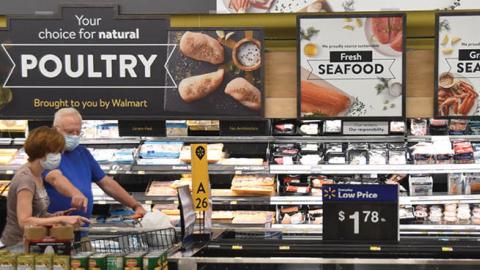With 15% of the US population now vaccinated against Covid-19, and more eligible for the shot every day, a vision of post-pandemic life is in sight. But for many, returning to a crowded supermarket is not part of that vision: online grocery shopping, a service that thrived during the pandemic, is here to stay for 81% of consumers. At a time when the pandemic has battered our health and waistlines – quarantined Americans gained more than a half a pound every 10 days — how grocers shape our online buying decisions can make us healthier…or not.
Supermarket chains are still figuring out how to influence people’s food choices online, like they do through the ever-present displays that drive impulse buys in brick-and-mortar stores. They have been tinkering with ways to “suggest” items to add to the virtual shopping cart. Unfortunately, many retailers are still suggesting the wrong things. They need to find ways to put healthier options in front of shoppers, for their own economic health as well as for their customers.
Healthier food is no longer a “fringe” opportunity. According to research firm Natural Marketing Institute, 62% of consumers are currently eating healthier or trying to adopt healthy eating habits. Covid-19 has made us more aware of the link between poor diets and poor health, and the desire to eat better has only grown stronger. Consider also that the segment of the population most devoted to health also has more money to spend. Food chains that help them easily find healthy options online will capture their dollars.
Another compelling factor for food retailers to consider are the millennials. Forty percent (40%) of millennials have changed their diets because they believe that helps the environment. This is a long-term trend and grocers must cater to the needs of the largest population cluster.
Most grocery chains have a lot of work to do to capitalize on these market dynamics and to help consumers change their eating habits. A few chains, like Raley’s based in California, make it easy for consumers to shop for healthier options that are organic, contain no added sugar or are sustainable. Even their “Top Deals for You” include specials on fresh produce, bottled water, fresh salmon and pasture-raised eggs. But most traditional food retailers like Walmart, Kroger and Albertson's offer little guidance – or encouragement – to purchase healthier options. The usual rogue’s gallery of less healthy foods occupies the marquee spots for promotions or daily specials, and finding better-for-you items often requires clicking through too many screens and avoiding too many tempting traps along the way. And in the helpful spirit of making virtual shopping easier, many online shopping tools suggest items that have been chosen in past shopping sessions, which can reinforce poor choices.
Here’s what food retailers must do to help their customers through the online shopping experience:
* Make it easier for consumers to find the healthier choices when they shop online rather than having to scavenger hunt for them. A majority of today’s consumers are trying to eat healthier, and grocers need to meet their needs by building in more algorithms and “recommendation engines” that put healthier options at hand, like Raley’s does. Or perhaps chains could spotlight their better-for-you items using a system such as Ahold Delhaize’s Guiding Stars for its supermarket banners including Stop & Shop, Food Lion, Giant and Hannaford Brothers.
* Reward shoppers with discounts for healthier choices. Just like in-store features and displays tempt shoppers with reduced prices, online incentives can go a long way to driving purchases of better-for-you products. Even some healthcare plans, such as UnitedHealthcare, sponsor “ Healthy Savings ” programs in which plan participants can save on healthier items meeting criteria based on the Guiding Stars system. More grocers need to sign up with such plans to drive healthy food sales.
* Feature healthier foods along with more traditional high-volume products. Food retailers have yet to figure out the formula on how to promote healthier products. Memories are long regarding failed efforts to promote and display only healthy items and the old adage of “stack ‘em high and watch ‘em fly” that was successful for soft drinks and other high volume items is firmly embedded. To accommodate shoppers who want to eat healthier, yet are unwilling to give up their favorite foods, online is a perfect opportunity to pilot joint “displays” incorporating both healthy and less healthy stalwarts to maximize consumer choice and store revenues.
Online shopping for grocery is here to stay and growing quickly. Consumers in a post-pandemic world are more willing to shop online, more open to new choices, and more eager to improve their health. This is a great opportunity for retailers to capitalize on this trend and shore up their revenues and consumer loyalty. Making it easier for shoppers to find healthy foods has to be part of that strategy.
Read in Forbes




















